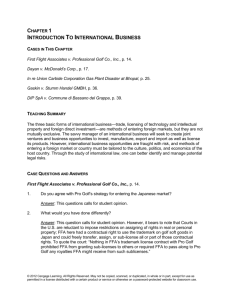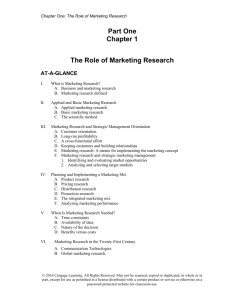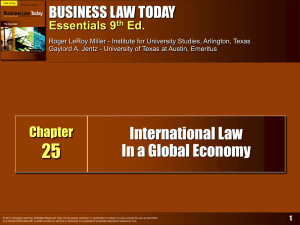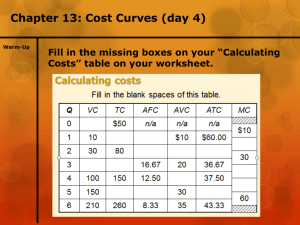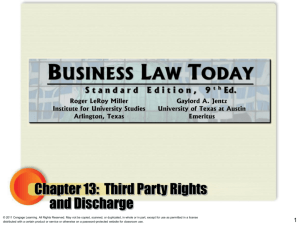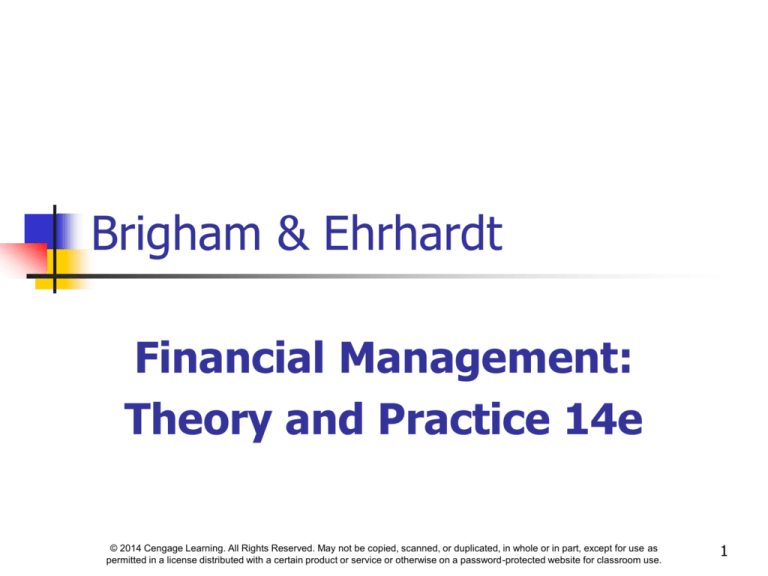
Brigham & Ehrhardt
Financial Management:
Theory and Practice 14e
© 2014 Cengage Learning. All Rights Reserved. May not be copied, scanned, or duplicated, in whole or in part, except for use as
permitted in a license distributed with a certain product or service or otherwise on a password-protected website for classroom use.
1
CHAPTER 16
Supply Chains and Working
Capital Management
© 2014 Cengage Learning. All Rights Reserved. May not be copied, scanned, or duplicated, in whole or in part, except for use as
permitted in a license distributed with a certain product or service or otherwise on a password-protected website for classroom use.
2
Topics in Chapter
Alternative current operating assets
investment and financing policies
Cash, inventory, and A/R management
Accounts payable management
Short-term financing
Bank loans, their costs, and commercial
paper
© 2014 Cengage Learning. All Rights Reserved. May not be copied, scanned, or duplicated, in whole or in part, except for use as
permitted in a license distributed with a certain product or service or otherwise on a password-protected website for classroom use.
3
Determinants of Intrinsic Value: Working Capital and FCF
Sales revenues
−
Operating costs and taxes
−
Required investments in operating capital
Free cash flow
(FCF)
Value =
=
FCF1
FCF2
FCF∞
+
+
···
+
(1 + WACC)1
(1 + WACC)2
(1 + WACC)∞
Weighted average
cost of capital
(WACC)
Market interest rates
Cost of debt
Firm’s debt/equity mix
Market risk aversion
Cost of equity
Firm’s business risk
© 2014 Cengage Learning. All Rights Reserved. May not be copied, scanned, or duplicated, in whole or in part, except for use as
permitted in a license distributed with a certain product or service or otherwise on a password-protected website for classroom use.
Basic Definitions
Net operating working capital (NOWC):
Operating CA – Operating CL =
(Cash + Inv. + A/R) – (Accruals + A/P)
Working capital:
Total current assets used in operations.
Net working capital:
Current assets – Current liabilities.
(More…)
© 2014 Cengage Learning. All Rights Reserved. May not be copied, scanned, or duplicated, in whole or in part, except for use as
permitted in a license distributed with a certain product or service or otherwise on a password-protected website for classroom use.
5
Definitions (Continued)
Working capital management:
Includes both establishing working
capital policy and then the day-to-day
control of cash, inventories, receivables,
accruals, and accounts payable.
Working capital policy:
The level of each current asset.
How current assets are financed.
© 2014 Cengage Learning. All Rights Reserved. May not be copied, scanned, or duplicated, in whole or in part, except for use as
permitted in a license distributed with a certain product or service or otherwise on a password-protected website for classroom use.
6
Selected Ratios for RR
RR
Industry
Current
1.75
2.25
Quick
0.92
1.16
58.76%
50.00%
Turnover of Cash
16.67
22.22
DSO(365-day year)
45.63
32.00
Inv. Turnover
10.80
20.00
F.A. Turnover
7.75
13.22
T.A. Turnover
2.60
3.00
Profit Margin
2.07%
3.50%
10.45%
21.00%
30.00
33.00
TL/Assets
ROE
Payables deferral
© 2014 Cengage Learning. All Rights Reserved. May not be copied, scanned, or duplicated, in whole or in part, except for use as
permitted in a license distributed with a certain product or service or otherwise on a password-protected website for classroom use.
7
How does RR’s working capital
policy compare with the industry?
Working capital policy is reflected in a
firm’s current ratio, quick ratio, turnover
of cash and securities, inventory
turnover, and DSO.
These ratios indicate RR has large
amounts of working capital relative to
its level of sales. Thus, RR is following
a relaxed policy.
© 2014 Cengage Learning. All Rights Reserved. May not be copied, scanned, or duplicated, in whole or in part, except for use as
permitted in a license distributed with a certain product or service or otherwise on a password-protected website for classroom use.
8
Is RR inefficient or just
conservative?
A relaxed policy may be appropriate if it
reduces risk more than profitability.
However, RR is much less profitable
than the average firm in the industry.
This suggests that the company
probably has excessive working capital.
© 2014 Cengage Learning. All Rights Reserved. May not be copied, scanned, or duplicated, in whole or in part, except for use as
permitted in a license distributed with a certain product or service or otherwise on a password-protected website for classroom use.
9
Cash Conversion Cycle
The cash conversion cycle focuses on the time
between payments made for materials and
labor and payments received from sales:
Cash
Inventory
Average
Payables
Conversion = Conversion + Collection − Deferral
Cycle
Period
Period
Period
© 2014 Cengage Learning. All Rights Reserved. May not be copied, scanned, or duplicated, in whole or in part, except for use as
permitted in a license distributed with a certain product or service or otherwise on a password-protected website for classroom use.
10
Cash Conversion Cycle (Cont.)
Data:
Annual sales = $660,000
COGS/Sales = 90%
Inventory turnover = COGS/Inventory = 10.8
COGS = (0.9)($660,000) = $594,000.
Inventory = $594,000/10.8 = $55,000.
Inv. Conv. = $55,000/($594,000/365)
= 33.8 days.
© 2014 Cengage Learning. All Rights Reserved. May not be copied, scanned, or duplicated, in whole or in part, except for use as
permitted in a license distributed with a certain product or service or otherwise on a password-protected website for classroom use.
11
Cash Conversion Cycle (Cont.)
CCC =
Payables
Inventory + Days sales –
deferral
conversion
outstanding
period
period
CCC = 33.8 + 45.6 – 30
CCC = 49.4 days.
© 2014 Cengage Learning. All Rights Reserved. May not be copied, scanned, or duplicated, in whole or in part, except for use as
permitted in a license distributed with a certain product or service or otherwise on a password-protected website for classroom use.
12
Cash Management: Cash doesn’t earn
interest, so why hold it?
Transactions (Routine): Must have some cash
to pay current bills.
Transactions (Precaution): “Safety stock.”
Essential that the firm have sufficient cash to take
trade discounts.
Not as much needed if company has credit line or
other holdings of short-term securities.
Compensating balances: For loans and/or
services provided.
© 2014 Cengage Learning. All Rights Reserved. May not be copied, scanned, or duplicated, in whole or in part, except for use as
permitted in a license distributed with a certain product or service or otherwise on a password-protected website for classroom use.
13
What’s the goal of cash
management?
Minimize the cash amount the firm must
hold for conducting its normal business
activities, yet, at the same time, have a
sufficient cash reserve to:
Take trade discounts.
Pay promptly and maintain its credit
rating.
Meet any unexpected cash needs.
© 2014 Cengage Learning. All Rights Reserved. May not be copied, scanned, or duplicated, in whole or in part, except for use as
permitted in a license distributed with a certain product or service or otherwise on a password-protected website for classroom use.
14
Ways to Minimize Cash
Holdings
Use lockboxes.
Insist on wire transfers or automatic
debit from customers.
Synchronize inflows and outflows.
Use float.
(More…)
© 2014 Cengage Learning. All Rights Reserved. May not be copied, scanned, or duplicated, in whole or in part, except for use as
permitted in a license distributed with a certain product or service or otherwise on a password-protected website for classroom use.
15
Minimizing Cash (Continued)
Increase forecast accuracy to reduce
the need for a cash “safety stock.”
Hold marketable securities instead of a
cash “safety stock.”
Negotiate a line of credit (also reduces
need for a “safety stock”).
© 2014 Cengage Learning. All Rights Reserved. May not be copied, scanned, or duplicated, in whole or in part, except for use as
permitted in a license distributed with a certain product or service or otherwise on a password-protected website for classroom use.
16
Cash Budget: The Primary
Cash Management Tool
Purpose: Uses forecasts of cash inflows,
outflows, and ending cash balances to predict
loan needs and funds available for temporary
investment.
Timing: Daily, weekly, or monthly,
depending upon budget’s purpose. Monthly
for annual planning, daily for actual cash
management.
© 2014 Cengage Learning. All Rights Reserved. May not be copied, scanned, or duplicated, in whole or in part, except for use as
permitted in a license distributed with a certain product or service or otherwise on a password-protected website for classroom use.
17
Data Required for Cash
Budget
Sales forecast.
Information on collections delay.
Forecast of purchases and payment
terms.
Forecast of cash expenses: wages,
taxes, utilities, and so on.
Initial cash on hand.
Target cash balance.
© 2014 Cengage Learning. All Rights Reserved. May not be copied, scanned, or duplicated, in whole or in part, except for use as
permitted in a license distributed with a certain product or service or otherwise on a password-protected website for classroom use.
18
RR’s Cash Budget for January
and February
Net Cash Inflows
January
February
Collections
$67,651.95
$62,755.40
Purchases
44,603.75
36,472.65
Wages
6,690.56
5,470.90
Rent
2,500.00
2,500.00
$53,794.31
$44,443.55
Total Payments
© 2014 Cengage Learning. All Rights Reserved. May not be copied, scanned, or duplicated, in whole or in part, except for use as
permitted in a license distributed with a certain product or service or otherwise on a password-protected website for classroom use.
19
Cash Budget (Continued)
January
February
Cash on hand at
start of forecast
$3,000.00
Net CF (Coll – Pymt)
13,857.64
18,311.85
$16,857.64
$35,169.49
– Target cash
1,500.00
1,500.00
Surplus cash
$15,357.64
$33,669.49
Cumulative NCF
© 2014 Cengage Learning. All Rights Reserved. May not be copied, scanned, or duplicated, in whole or in part, except for use as
permitted in a license distributed with a certain product or service or otherwise on a password-protected website for classroom use.
20
Should depreciation be explicitly
included in the cash budget?
No. Depreciation is a noncash charge.
Only cash payments and receipts
appear on cash budget.
However, depreciation does affect
taxes, which do appear in the cash
budget.
© 2014 Cengage Learning. All Rights Reserved. May not be copied, scanned, or duplicated, in whole or in part, except for use as
permitted in a license distributed with a certain product or service or otherwise on a password-protected website for classroom use.
21
What are some other potential
cash inflows besides collections?
Proceeds from fixed asset sales.
Proceeds from stock and bond sales.
Interest earned.
Court settlements.
© 2014 Cengage Learning. All Rights Reserved. May not be copied, scanned, or duplicated, in whole or in part, except for use as
permitted in a license distributed with a certain product or service or otherwise on a password-protected website for classroom use.
22
How can interest earned or paid on shortterm securities or loans be incorporated in
the cash budget?
Interest earned: Add line in the collections
section.
Interest paid: Add line in the payments
section.
Found as interest rate x surplus/loan line of
cash budget for preceding month.
Note: Interest on any other debt would need
to be incorporated as well.
© 2014 Cengage Learning. All Rights Reserved. May not be copied, scanned, or duplicated, in whole or in part, except for use as
permitted in a license distributed with a certain product or service or otherwise on a password-protected website for classroom use.
23
How could bad debts be
worked into the cash budget?
Collections would be reduced by the
amount of bad debt losses.
For example, if the firm had 3% bad
debt losses, collections would total only
97% of sales.
Lower collections would lead to lower
surpluses and higher borrowing
requirements.
© 2014 Cengage Learning. All Rights Reserved. May not be copied, scanned, or duplicated, in whole or in part, except for use as
permitted in a license distributed with a certain product or service or otherwise on a password-protected website for classroom use.
24
Cash budget forecasts the company’s cash
holdings to exceed targeted cash balance every
month, except for October and November.
Cash budget indicates the company
probably is holding too much cash.
RR could improve its EVA by either
investing its excess cash in more
productive assets or by paying it out to
the firm’s shareholders.
© 2014 Cengage Learning. All Rights Reserved. May not be copied, scanned, or duplicated, in whole or in part, except for use as
permitted in a license distributed with a certain product or service or otherwise on a password-protected website for classroom use.
25
Why might RR want to maintain a
relatively high amount of cash?
If sales turn out to be considerably less than
expected, RR could face a cash shortfall.
A company may choose to hold large
amounts of cash if it does not have much
faith in its sales forecast, or if it is very
conservative.
The cash may be there, in part, to fund a
planned fixed asset acquisition.
© 2014 Cengage Learning. All Rights Reserved. May not be copied, scanned, or duplicated, in whole or in part, except for use as
permitted in a license distributed with a certain product or service or otherwise on a password-protected website for classroom use.
26
Is RR holding too much
inventory?
RR’s inventory turnover (10.80) is
considerably lower than the industry average
(20.00). The firm is carrying a lot of
inventory per dollar of sales.
By holding excessive inventory, the firm is
increasing its operating costs which reduces
its NOPAT. Moreover, the excess inventory
must be financed, so EVA is further lowered.
© 2014 Cengage Learning. All Rights Reserved. May not be copied, scanned, or duplicated, in whole or in part, except for use as
permitted in a license distributed with a certain product or service or otherwise on a password-protected website for classroom use.
27
If RR reduces its inventory, without
adversely affecting sales, what effect will
this have on its cash position?
Short run: Cash will increase as
inventory purchases decline.
Long run: Company is likely to then
take steps to reduce its cash holdings.
© 2014 Cengage Learning. All Rights Reserved. May not be copied, scanned, or duplicated, in whole or in part, except for use as
permitted in a license distributed with a certain product or service or otherwise on a password-protected website for classroom use.
28
Accounts Receivable Management: Do
RR’s customers pay more or less promptly
than those of its competitors?
RR’s days’ sales outstanding (DSO) of
45.6 days is well above the industry
average (32 days).
RR’s customers are paying less
promptly.
RR should consider tightening its credit
policy to reduce its DSO.
© 2014 Cengage Learning. All Rights Reserved. May not be copied, scanned, or duplicated, in whole or in part, except for use as
permitted in a license distributed with a certain product or service or otherwise on a password-protected website for classroom use.
29
Elements of Credit Policy
Cash Discounts: Lowers price. Attracts
new customers and reduces DSO.
Credit Period: How long to pay?
Shorter period reduces DSO and
average A/R, but it may discourage
sales.
(More…)
© 2014 Cengage Learning. All Rights Reserved. May not be copied, scanned, or duplicated, in whole or in part, except for use as
permitted in a license distributed with a certain product or service or otherwise on a password-protected website for classroom use.
30
Credit Policy (Continued)
Credit Standards: Tighter standards
reduce bad debt losses, but may reduce
sales. Fewer bad debts reduces DSO.
Collection Policy: Tougher policy will
reduce DSO, but may damage customer
relationships.
© 2014 Cengage Learning. All Rights Reserved. May not be copied, scanned, or duplicated, in whole or in part, except for use as
permitted in a license distributed with a certain product or service or otherwise on a password-protected website for classroom use.
31
Does RR face any risk if it
tightens its credit policy?
YES! A tighter credit policy may
discourage sales. Some customers may
choose to go elsewhere if they are
pressured to pay their bills sooner.
© 2014 Cengage Learning. All Rights Reserved. May not be copied, scanned, or duplicated, in whole or in part, except for use as
permitted in a license distributed with a certain product or service or otherwise on a password-protected website for classroom use.
32
If RR succeeds in reducing DSO without
adversely affecting sales, what effect
would this have on its cash position?
Short run: If customers pay sooner,
this increases cash holdings.
Long run: Over time, the company
would hopefully invest the cash in more
productive assets, or pay it out to
shareholders. Both of these actions
would increase EVA.
© 2014 Cengage Learning. All Rights Reserved. May not be copied, scanned, or duplicated, in whole or in part, except for use as
permitted in a license distributed with a certain product or service or otherwise on a password-protected website for classroom use.
33
Is there a cost to accruals?
Can firms control accruals?
Accruals are free in that no explicit
interest is charged.
Firms have little control over the level
of accruals. Levels are influenced more
by industry custom, economic factors,
and tax laws.
© 2014 Cengage Learning. All Rights Reserved. May not be copied, scanned, or duplicated, in whole or in part, except for use as
permitted in a license distributed with a certain product or service or otherwise on a password-protected website for classroom use.
34
What is trade credit?
Trade credit is credit furnished by a
firm’s suppliers.
Trade credit is often the largest source
of short-term credit, especially for small
firms.
Spontaneous, easy to get, but cost can
be high.
© 2014 Cengage Learning. All Rights Reserved. May not be copied, scanned, or duplicated, in whole or in part, except for use as
permitted in a license distributed with a certain product or service or otherwise on a password-protected website for classroom use.
35
RR buys $200,000 of materials net, on
terms of 1/10, net 30 but pays on Day 40.
Find free and costly trade credit.
Net daily purchases = $200,000/365
= $547.94.
Ann. gross purch.= $200,000/(1 – 0.01)
= $202,020.
© 2014 Cengage Learning. All Rights Reserved. May not be copied, scanned, or duplicated, in whole or in part, except for use as
permitted in a license distributed with a certain product or service or otherwise on a password-protected website for classroom use.
36
Gross/Net Breakdown
Company buys equip worth $200,000.
That’s the equipment’s cash price.
The firm must pay $2,020 more if it
doesn’t take discounts.
Think of the extra $2,020 as a financing
cost similar to the interest on a loan.
Want to compare that cost with the cost
of a bank loan.
© 2014 Cengage Learning. All Rights Reserved. May not be copied, scanned, or duplicated, in whole or in part, except for use as
permitted in a license distributed with a certain product or service or otherwise on a password-protected website for classroom use.
37
Free and Costly Trade Credit
Payables level for equipment if take discount:
Payables = $547.94(10) = $5,479.
Payables level if don’t take discount:
Payables = $547.94(40) = $21,918.
Total trade credit
Free trade credit
Costly trade credit
= $21,918
= 5,479
= $16,439
© 2014 Cengage Learning. All Rights Reserved. May not be copied, scanned, or duplicated, in whole or in part, except for use as
permitted in a license distributed with a certain product or service or otherwise on a password-protected website for classroom use.
38
Nominal Cost of Costly Trade
Credit, rNOM
Firm loses 0.01($202,020) = $2,020 of
discounts to obtain $16,439 in extra
trade credit, so:
rNOM
$2,020
= $16,439
= 0.1229 = 12.29%
But the $2,020 is paid all during the
year, not at year-end, so effective annual
rate is higher.
© 2014 Cengage Learning. All Rights Reserved. May not be copied, scanned, or duplicated, in whole or in part, except for use as
permitted in a license distributed with a certain product or service or otherwise on a password-protected website for classroom use.
39
Nominal Cost Formula, 1/10,
net 40
rNOM = Discount %
×
1 – Discount %
1
=
99
×
365
30
365 days
Days
Taken
–
Discount
Period
= 0.0101 × 12.1667
= 0.1229 = 12.29%
Pays 1.01% 12.167 times per year.
© 2014 Cengage Learning. All Rights Reserved. May not be copied, scanned, or duplicated, in whole or in part, except for use as
permitted in a license distributed with a certain product or service or otherwise on a password-protected website for classroom use.
40
Effective Annual Rate (EAR),
1/10, net 40
Periodic rate = 0.01/0.99 = 1.01%.
Periods/year = 365/(40 – 10)
= 12.1667.
EAR
= (1 + Periodic rate)n – 1.0
= (1.0101)12.1667 – 1.0
= 13.01%.
© 2014 Cengage Learning. All Rights Reserved. May not be copied, scanned, or duplicated, in whole or in part, except for use as
permitted in a license distributed with a certain product or service or otherwise on a password-protected website for classroom use.
41
Current Operating Assets
Financing Policies
Moderate: Match the maturity of the
assets with the maturity of the
financing.
Aggressive: Use short-term financing
to finance permanent assets.
Conservative: Use permanent capital
for permanent assets and temporary
assets.
© 2014 Cengage Learning. All Rights Reserved. May not be copied, scanned, or duplicated, in whole or in part, except for use as
permitted in a license distributed with a certain product or service or otherwise on a password-protected website for classroom use.
42
Moderate Financing Policy
$
Temp. NOWC
}
Perm NOWC
S-T
Loans
L-T Fin:
Stock &
Bonds,
Fixed Assets
Years
Lower dashed line, more aggressive.
© 2014 Cengage Learning. All Rights Reserved. May not be copied, scanned, or duplicated, in whole or in part, except for use as
permitted in a license distributed with a certain product or service or otherwise on a password-protected website for classroom use.
43
What are the advantages of shortterm debt vs. long-term debt?
Low cost-- yield curve usually slopes
upward.
Can get funds relatively quickly.
Can repay without penalty.
© 2014 Cengage Learning. All Rights Reserved. May not be copied, scanned, or duplicated, in whole or in part, except for use as
permitted in a license distributed with a certain product or service or otherwise on a password-protected website for classroom use.
44
What are the disadvantages of shortterm debt vs. long-term debt?
Higher risk. The required repayment
comes quicker, and the company may
have trouble rolling over loans.
© 2014 Cengage Learning. All Rights Reserved. May not be copied, scanned, or duplicated, in whole or in part, except for use as
permitted in a license distributed with a certain product or service or otherwise on a password-protected website for classroom use.
45
Commercial Paper (CP)
Short term notes issued by large, strong
companies. RR couldn’t issue CP--it’s
too small.
CP trades in the market at rates just
above T-bill rate.
CP is bought with surplus cash by banks
and other companies, then held as a
marketable security for liquidity
purposes.
© 2014 Cengage Learning. All Rights Reserved. May not be copied, scanned, or duplicated, in whole or in part, except for use as
permitted in a license distributed with a certain product or service or otherwise on a password-protected website for classroom use.
46




